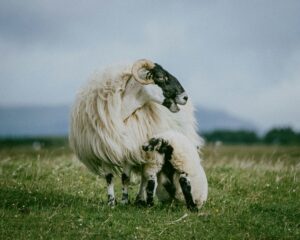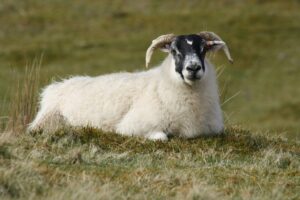Scotland’s rolling hills, remote glens, and misty moors are home to more than just stunning views, they are home to millions of sheep. Scotland has consistently had more sheep than people, making this fluffy fact one of the most surprising quirks of the country.
As of the most recent statistics, Scotland’s human population in mid-2023 was around 5.4 million, but the sheep population is even higher! Estimated at over 6.5 million sheep in Scotland. In rural areas like the Highlands, the Western Isles, and Shetland, sheep often outnumber humans.
Sheep farming plays a vital role in Scotland’s agricultural industry and rural economy. You will see plenty of sheep from the rugged Scottish Highlands to the softer Lowlands. With a mix of both upland and lowland breeds, flocks can be seen dotting the hillsides, open fields, and even remote islands. Thanks to their ability to cope with harsh weather and rugged terrain, sheep became vital livestock in the Highlands and Islands.
Many farmers rear sheep for meat and wool, and the sector supports thousands of jobs, from crofters in the Hebrides to large-scale farms in the Borders.
Whether you’re visiting Skye, the Cairngorms, or Dumfries and Galloway, spotting sheep is part of the Scottish travel experience. Don’t be surprised if one strolls across the road at its own pace.
One of the most iconic breeds is the Scottish Blackface. A hardy, resilient, and perfectly adapted to Scotland’s harsher terrains. These sheep are easily recognised by their black faces and curled horns.
In addition to native breeds, many farms also rear Cheviots, Texels, and Suffolks, depending on the purpose of the flock and the nature of the land.

Breeding is a core part of sheep farming in Scotland. Around 40% of the national flock are breeding ewes (female sheep), while only 1% are rams (male sheep). Just one well-selected ram can mate with several ewes. Picking the correct ram is essential to ensuring a strong lambing season is ahead.
Scottish sheep have helped shape national identity through wool. Their fleece has long been used to produce tartan, the patterned cloth worn in kilts and other traditional garments. Woollen mills, particularly in the Borders and the Islands, are still important to Scotland’s rural economy today.
From cosy jumpers to iconic kilts, much of what people associate with Scottish tradition begins with the humble sheep.
You don’t need to go far in Scotland to see sheep, they are practically everywhere. Top places include:
When exploring the Scottish Countryside, especially on single-track roads, always drive with care. Sheep roam freely and sometimes appear without warning in the middle of the road.
Yes! Scotland has over 6.5 million sheep, while the human population is around 5.4 million.
Scotland’s rugged hills, cool climate, and strong farming tradition make it ideal for sheep. Much of the Scottish landscape isn’t suitable for crops but is perfect for grazing.
Definitely, sheep are a common sight across the Highlands, Borders, Islands, and Lowlands.
A baby sheep is called a lamb. Spring is lambing season in Scotland, and you’ll often see lambs bouncing around fields in the Countryside.
A male sheep is known as a ram, and a female is called a ewe (pronounced “you”).
Sheep mainly graze on grass, but they also eat hay, silage, and sheep feed when needed. They drink fresh water from streams, troughs, or water tanks.
The idea of counting sheep to fall asleep dates back centuries. It’s a calming mental exercise to distract the mind and help you fall asleep. Picture a peaceful Scottish hillside with sheep dotting the slopes and start counting!
